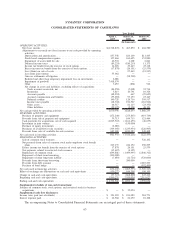Symantec 2009 Annual Report Download - page 130
Download and view the complete annual report
Please find page 130 of the 2009 Symantec annual report below. You can navigate through the pages in the report by either clicking on the pages listed below, or by using the keyword search tool below to find specific information within the annual report.the Services operating segment was comprised of two components that each represented a reporting unit: SaaS and
Services.
Intangible Assets. In connection with our acquisitions, we generally recognize assets for customer rela-
tionships, developed technology or acquired product rights (purchased product rights, technologies, databases,
patents, and contracts) and tradenames. Intangible assets and long-lived assets are recognized at cost less
accumulated amortization. Amortization of intangible assets is provided on a straight-line basis over the estimated
useful lives of the respective assets, generally from one to nine years. Amortization for acquired product rights is
recognized in Cost of revenues. Amortization for customer lists and tradenames is recognized in Operating
expenses.
On an interim basis, we ascertain triggering events for impairment of intangible assets and assess recover-
ability in accordance with SFAS No. 142 for intangible assets with indefinite lives or SFAS No. 144 for intangible
assets with definite lives. To determine the recoverability of our definite-lived intangible assets, when indicators of
an impairment are identified, we compare the carrying amounts against the estimated future cash flows related to
the underlying group of assets. These estimates are based on company forecasts and are subject to change. We also
evaluate net realizability of acquired product rights in accordance with SFAS No. 86.
Assets Held For Sale
Assets to be sold or disposed of are included in Other current assets and reported at the lower of the carrying
amount or fair value less costs to sell, and are no longer depreciated. We evaluate assets held for sale for impairment
whenever events or changes in circumstances indicate that the carrying amount of an asset may not be recoverable in
accordance with SFAS No. 144. If the estimated fair value is less than its carrying amount, an impairment loss is
recognized. The impairment loss is measured as the difference between the carrying amount of the asset and its fair
value, which is estimated based on appraised market values or discounted cash flows expected to be generated by
the asset. Impairment charges are included in “Impairment of assets held for sale.” The gain or loss on the sale of
assets held for sale are included in nonoperating expenses.
Restructuring Liabilities
Upon approval of a restructuring plan by management with the appropriate level of authority, we record
restructuring liabilities in accordance with SFAS No. 112, Employers’ Accounting for Postemployment Benefits,
and SFAS No. 146, Accounting for Costs Associated with Exit or Disposal Activities, resulting in the recognition of
employee severance and related termination benefits for recurring arrangements when they become probable and
estimable and on the accrual basis for one-time benefit arrangements. We record other costs associated with exit
activities as they are incurred.
Income Taxes
We account for income taxes in accordance with SFAS No. 109, Accounting for Income Taxes. The provision
for income taxes is computed using the asset and liability method, under which deferred tax assets and liabilities are
recognized for the expected future tax consequences of temporary differences between the financial reporting and
tax bases of assets and liabilities, and for operating loss and tax credit carryforwards in each jurisdiction in which we
operate. Deferred tax assets and liabilities are measured using the currently enacted tax rates that apply to taxable
income in effect for the years in which those tax assets are expected to be realized or settled. We record a valuation
allowance to reduce deferred tax assets to the amount that is believed more likely than not to be realized.
We are required to compute our income taxes in each federal, state, and international jurisdiction in which we
operate. This process requires that we estimate the current tax exposure as well as assess temporary differences
between the accounting and tax treatment of assets and liabilities, including items such as accruals and allowances
not currently deductible for tax purposes. The income tax effects of the differences we identify are classified as
70
SYMANTEC CORPORATION
Notes to Consolidated Financial Statements — (Continued)
























